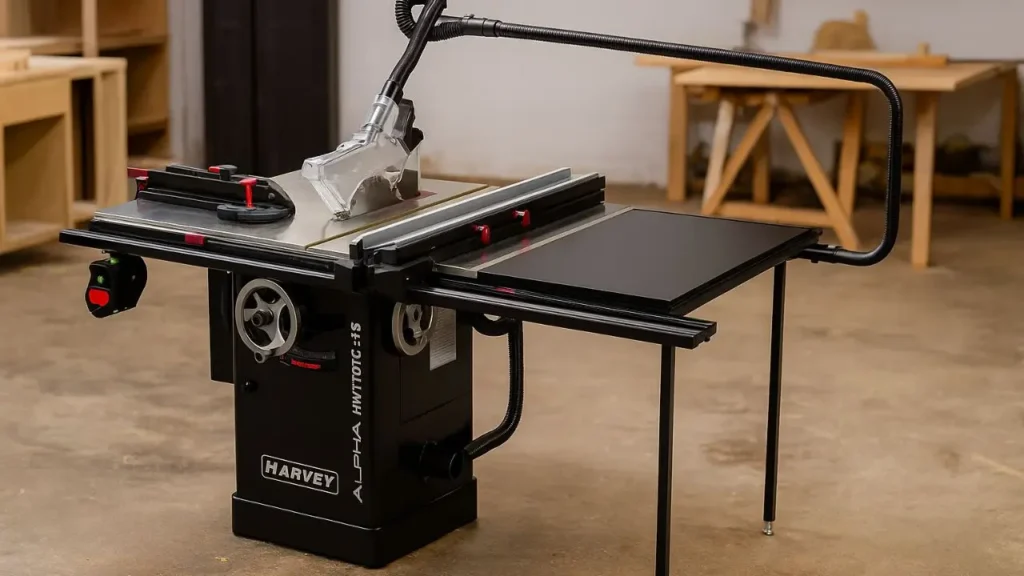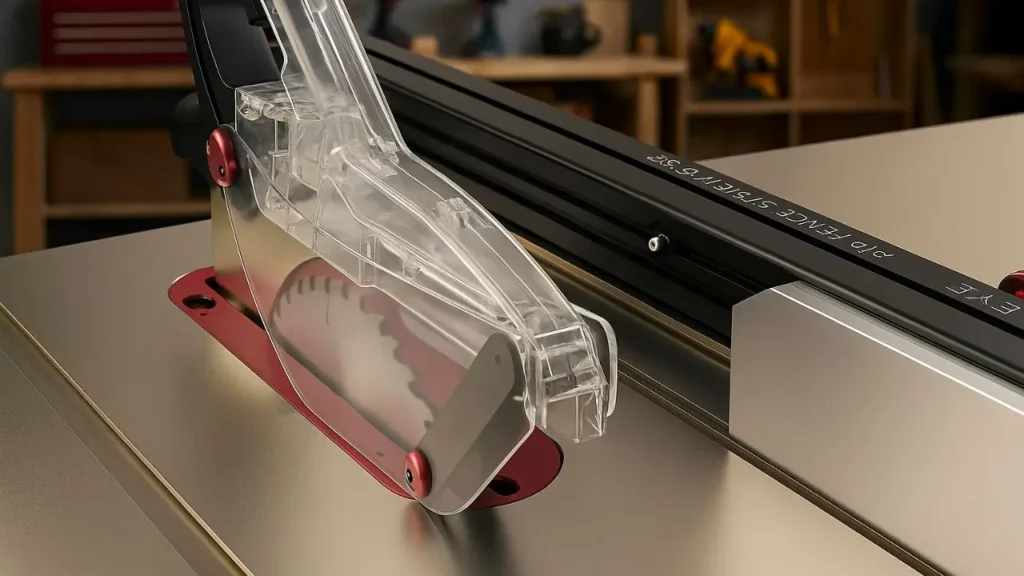Quick Summary: Harvey Table Saw Tested: A Cabinet Maker’s 500-Hour Journey
- Content Type: Hand Tested Review
- Last Updated: July 17, 2025
- Fact-Checked By: Muhammad Ali - Ghazi Autos
- Best For: Serious woodworkers and cabinet makers who trust their experience and value rock-solid build quality over high-tech safety features.
- What’s Great: The fence is a game-changer—dead-on accurate every time—and the powerful motor chews through thick hardwood without a problem
- What’s Not: A few small annoyances, like insert screws that need occasional tightening and a miter gauge you'll probably want to upgrade.
- Buy If: You're ready to make a 'buy it for life' investment in your workshop and demand uncompromising accuracy and power.
- Avoid If: You want the peace of mind that comes with SawStop's safety tech, or you're a weekend hobbyist who doesn't need this much saw.
- Affiliate Link Present: Yes
- Price at Review Date: Expect to pay around $2,800 to $3,800, but keep an eye out for some pretty impressive sales.
- Available At: You won't find this on Amazon; you'll need to go directly to Harvey or one of their official dealers.
I spent almost two years digging into and comparing Harvey table saws before I finally decided to move on from my reliable Craftsman contractor saw. Setting up my new 22×22 detached shop meant rethinking my woodworking tools, and upgrading my table saw became the top priority. It’s the tool I rely on the most.

I’ve now worked with my Harvey Alpha table saw every single day for over 15 months. I’ve used it on everything from basic cuts to tough hardwood projects and put it to the test. Back when I was shopping for this centerpiece tool for my workshop, I planned to spend somewhere between $4,000 and $7,500. This price range put the Harvey saw right up against the SawStop, although the SawStop was a little out of reach due to its extra features. But choosing the best cabinet table saw for your needs isn’t just about how much it costs. In this detailed review, I’ll break down my hands-on experience after 500 hours of use. I’ll talk about how it performs how well it is built, and whether it was a good investment for my woodworking business.
Disclaimer
Affiliate Disclaimer
I want to be 100% honest with you. Some links you see in my post are ‘affiliate links’. This just means if you click one of my links and then buy a tool, I get a very small money from the shop.
This does not cost you any extra money at all. The price is the same for you.
This small help lets me keep this blog alive and test more tools for you. Please know, I only link to tools I have used myself or received a verified review of the tool and believe are good. My words and my review are my own, nobody pays me to say nice things. Thank you for your support!
Image Information
All product images used in this post are provided by the author and claimed to be their own usage. According to the author, these images are either self-clicked, taken during hands-on testing, or screenshots captured for review purposes. If you believe any image violates your rights, please contact us for proper credit or removal.
Price & Stock Information
The product prices and availability mentioned in this post are accurate as of the time of publishing. However, prices may change on the seller’s website without notice. Please always check the latest price and stock status on the official product page before making a purchase decision.
- 36-INCH T-GLIDE FENCE ASSEMBLY: The 36-inch T-Glide Fence & Rail are made of heavy-gauge steel for sure lockdown and rel…
- SAWSTOP PATENTED SAFETY SYSTEM: Stops a spinning blade on contact with skin. The blade stops in less than 5 milliseconds…
- UNMATCHED QUALITY: The trunnion and arbor are built for precision, strength and stability. The gas piston elevation deli…
Harvey Alpha Table Saw (3HP) Setup and Specs
I unpacked my Harvey Alpha Table Saw and was impressed by its specifications right away. Its 3HP motor built for 220V, stood out as a strong core for the machine and handled heavy cabinet-making jobs with ease. This motor, a TEFC induction type, provided steady operation and didn’t slow down even while cutting dense hardwood.
Motor: 3HP Wired for 220V
The motor spins at 3500 RPM and connects to the blade through a V-ribbed belt drive. This design caught my eye because it kept vibrations to a minimum when I made my first cuts. The way it holds consistent torque even through long sessions of cutting, made a big difference during projects that needed extended use.
Cast Iron Top with Aluminum Insert
The cast iron tabletop has a smooth finish and measures 31.5 inches by 22.44 inches with a thickness of 1.83 inches. Its standout feature comes from a chemical nickel-plating process, which bonds nickel with the surface and delivers a remarkable hardness ranging from 500 to 700 HV. After using it for over a year, I haven’t noticed any rust or major wear. This shows how effective Harvey’s surface treatment is. The aluminum insert keeps the table rigid while making it simple to change blades.
Overview of the Big Eye Rip Fence System

The Big Eye Rip Fence System stands out as the most remarkable feature. Eight bearings roll on steel rods offering precise fence movement accurate to 0.15mm across its entire length. A dual-end locking system works in sync to stop the fence from shifting while cutting keeping accuracy within 0.02mm. The micro-adjustment knob helps fine-tune the fence’s position, and four flip stops make repeated cuts easy. The fence also includes K9 crystal glass windows that offer 92% light transmission reducing parallax errors when checking measurements.
Add-ons for Router Table and Dust Collection
I set up my workspace with the COMPASS RT800 router table system. It uses the RF36I fence. The cast iron extension gives a sturdy and steady surface to handle routing tasks without vibrations. The table works with router lifts from brands like SawStop, Incra, JessEM, and Rockler. To manage dust , I installed the RT-DC dust cabinet. It attaches to the saw’s 4-inch dust port. This setup helps keep the workshop neat while working.
How It Holds Up After 500 Hours
A table saw shows its true worth when it’s been used for a long time. After putting my Harvey Alpha through daily projects in cabinet making, I’ve learned a lot about how it performs in real-world situations.
Cutting Through 2-Inch Hickory and Maple
This saw performs best when slicing through thick hardwoods. I’ve ripped hundreds of feet of kiln-dried hickory that was two inches thick and got great results. Using a Freud Glue Line Rip blade, it made clean smooth cuts right through the hickory in just one pass. Working with hard maple gave similar results, though I had to adjust the feed rate a little. To compare when I tried the Forrest Woodworker II blade, which has more teeth, the saw had to work harder, and I noticed burn marks now and then on these tougher woods.
Switching Blades and Cut Results
Switching blades is now a regular task in my work routine. The aluminum insert lets me access the blade , and my tests have shown the arbor has very little runout—just 0.003 inches. The quality of the cuts depends a lot on the type of blade being used. When I use sharp blades that are made for specific purposes, the Harvey cuts materials very cleanly. The saw also stays calibrated and does not lose its settings, which is a common issue with cheaper models that often fall out of alignment.
Fence Accuracy and Adjustments
Over 500 hours of use, I adjusted my fence just two times. The fence moves across the table with the thickness of a business card between it and the surface. The eight roller bearings in the Big Eye system help keep the fence in line when locked in place. One thing I really appreciate is the fine adjustment thumbwheel. It eliminates the need to “tap-tap-tap” to make small tweaks.
My Experience Calibrating the Bevel Stop
The bevel stop system kept working well even after long-term use. Both the 45° and 90° positive stops stayed accurate even with months of frequent use. Tuning it is simple. You can adjust it using set screws on the side panels. Because of this, my bevel cuts continue to stay precise, which matters when I’m working on cabinets.
What Worked and What Didn’t
After spending over 500 hours using the Harvey Alpha, I can say what stood out and what fell short. Like any piece of equipment, it has its high points and drawbacks even as a top-tier saw.
Highlights: Fence, Table Space, Build Quality
The Big Eye fence system makes this saw stand out. It feels rock-solid when locked into place and moves so that making precise changes is a breeze. The micro-adjustment knob lets you tweak cuts by tiny amounts even down to fractions of a millimeter, which is a game-changer to achieve exact joinery.
What also impressed me is the large surface area. The huge cast iron top provides amazing support for workpieces. Its chemical nickel-plating has held up well with no wear or rust even after daily use. I also didn’t expect the build to be this good. All the parts fit together, the settings don’t budge, and the powder-coated cabinet hasn’t chipped or shown any damage either.
Frustrations: Insert Screws and the Bevel Stop Nut
The Harvey Alpha works well overall, but it has a couple of small irritations. The insert plate screws need tightening because they loosen during heavy use. While this doesn’t cause big problems, you still need to tighten them now and then to stop the insert from rattling.
The bevel stop nut could have been designed better. You have to take off the side panel to adjust it, which interrupts your workflow when you’re fine-tuning bevel angles. For a saw in this price range, an easier way to adjust it would have been better.
Mobile Base and Miter Gage Drawbacks
The mobile base sold as an add-on does its job but feels weaker compared to the sturdiness of the saw itself. It helps move the saw around when needed, but the locking system doesn’t give the same sense of reliability as the rest of the setup. Before doing important cuts, I make sure to double-check if it’s secured.
The included miter gage works fine but doesn’t stand out. I’ve replaced it with a better aftermarket option to get more accurate crosscuts. With a high-end saw like the Harvey Alpha, I expected the miter gage to be on par with the quality of its fence system.
Is the Harvey Alpha the Right Cabinet Table Saw for You?
Picking between high-end cabinet saws really depends on what matters most to you. After using Harvey Alpha and comparing it with other options, I can share some useful thoughts.
Harvey Table Saw vs. SawStop: Main Differences
The biggest contrast between these two brands lies in how they handle safety. SawStop leads the way with its unique finger-saving brake system that prevents injuries, while Harvey sticks to more traditional safety design but with a stronger focus on build quality. When it comes to pure toughness and weight, Harvey comes out ahead. However, SawStop balances or even surpasses many of Harvey’s strengths by using smarter materials and advanced methods.
To collect dust, SawStop uses two separate vents and designed airflow shrouds that improve portability. On the other hand, Harvey gives users more options to upgrade with third-party fences. SawStop however, sticks to its own inserts and cartridges within its ecosystem.
Who Should Think About Getting the Harvey Tablesaw
The Harvey Alpha works best for skilled woodworkers who want excellent precision and solid construction over safety tech like flesh detection. Its strong 3HP motor makes tough jobs like cutting 2-inch kiln-dried hickory simple making it a good pick for experts who often deal with thick hardwoods. Craftsmen looking for high-level accuracy might appreciate the Big Eye Rip Fence System, which includes micro-adjusting features.
Harvey’s chemical nickel-plated coating, with a hardness of 500HV to 700HV, gives it excellent rust protection. This makes it useful in damp workspaces or for people who want to avoid dealing with the upkeep of cast iron.
Price vs Value: Is the Cost Justifiable?
Harvey table saws come with higher price tags. Their limited production numbers and experienced workforce add to the cost. Even so, they often include generous discounts. I’ve spotted deals taking USD 1,200 off cutting the 4HP model’s price from USD 3,299 to USD 1,999.
Although shipping costs are higher than what competitors offer, the value still holds due to the durable build precise craftsmanship, and unique features like the Big Eye fence system. After thorough testing in actual scenarios, this product proves its worth by delivering professional-level performance. Serious woodworkers looking to invest in a tool that lasts a lifetime instead of something temporary, will find the price justified.
Conclusion
With over 500 hours of daily use in my workshop, this Harvey Alpha table saw has shown it’s worth every penny. The strong 3HP motor gets through thick hardwood cuts without breaking a sweat. The Big Eye fence system stands out as the best part delivering accuracy that sticks around day after day. On top of that, the chemical nickel-plated surface has stayed in great shape even after constant work in my busy shop.
That said, it’s not without a couple of small frustrations. The screws on the insert plate need tightening now and then, and the bevel stop adjustment could use a more user-friendly design. Still, these small flaws matter when compared to how solid and reliable the saw is overall.
SawStop stands out because it uses flesh-detection technology to offer safety that no other saw matches. Harvey, on the other hand, leans into heavy-duty construction and precise design. This key difference makes Harvey better suited to woodworkers with expertise, who care more about long-lasting quality and sharp accurate cuts.
But was spending this much money worth it? . The fence’s fine-tune adjustment features and the saw’s reliable settings have boosted how I work in my shop. On top of that, the nickel-plated surface completely solves the rust problem I used to deal with on my old saw.
This Harvey table saw feels more like a long-term commitment than a simple tool buy. Woodworkers aiming to get pro-level results with hardwoods, will find the Harvey Alpha lives up to its premium price with outstanding performance. I rely on tools that offer accuracy and dependability for my business. This saw delivers on both counts, no shortcuts.
Key Points to Know
After 500 hours of heavy use, a cabinet maker’s hands-on experience shows the Harvey Alpha table saw’s real-world value and performance for woodworkers who take their craft .
- With its 3HP motor and Big Eye fence system, the Harvey Alpha ensures incredible accuracy needing just two fence tweaks after 500 hours of regular use.
- The chemical nickel-plated surface (500-700 HV hardness) resists rust and keeps the tool in top shape even with regular use in workshops.
- Harvey focuses on industrial-grade construction instead of safety features like SawStop’s flesh-detection system, which suits experienced woodworkers.
- Small issues include loose insert screws and bevel stop adjustments that are hard to reach, but these do not affect how well it performs overall.
- With a price of $3,299 (often marked down to $1,999), the Harvey Alpha earns its cost with durable professional-level build quality and long-lasting reliability.
The Harvey Alpha is a lifetime-worthy choice to achieve precision top-notch cut quality, and solid construction for skilled woodworkers who value performance over cutting-edge safety.




for heavy work they are good but also they consume high electricity
You are right